#liberatory imagination
Explore tagged Tumblr posts
Text
“I believe that we are in an imagination battle, and almost everything about how we orient towards our bodies is shaped by fearful imaginations. Imaginations that fear Blackness, brownness, fatness, queerness, disability, difference. Our radical imagination is a tool for decolonization, for reclaiming our right to shape our lived reality.”
adrienne maree brown
Pleasure Activism
#adrienne maree brown#pleasure activism#liberation#liberatory imagination#decolonization#quotes#books#book quotes#bookblr
14 notes
·
View notes
Text
youtube
0 notes
Text
nothing will give me more psychic damage than waking up to a AsAm tiktoker posting repackaged antisemitism (economic scapegoatism) against another minority in a different political context! and framing it like it's some quirky asian fax!
this is like a recurring issue among AsAm/AsCan communities where they are just completely disconnected from their homelands. and i dont mean like "oh im not fluent" and not being able to access knowledge by "virtue" of language barriers. i mean politically speaking... some of the things ive seen them post PUBLICLY. FACE OUT. that they would not be comfortable saying if they were actually familiar with the socio-political context of their homelands
#pol#beans of consciousness#imagine posting about how chinese indonesians are the 5% that hoards wealth#and ofc the comments are just awful#top comment is calling chinese the jews of sea#third one was a well well well type comment that was like. curious u can say this abt the chinese. but not ANOTHER GROUP...#i truly do not appreciate anyone who resorts to economic scapegoatism under the guise of liberatory rhetoric#gee its almost like if you use the rhetoric of economic spagegoatism your target audience are antisemites sinophobes and indophobes etc etc#the way they talk about the provinces who faced the brunt of euro imperialism at the time most sea cn migrated. truly disgusting.#also saw someone being like. the chinese AND hindus in malaysia r also hoarding!!! huh. me when i have zero historical analysis
3 notes
·
View notes
Text
youtube
anarchism is not achievable in our lifetime but it’s still the most ethical goal to continually reach for. no one is trying to take away your prescriptions. we want to build a world where you’re not afraid of dying because you can’t afford them because a capitalist is holding life-saving technology for ransom.
#anarchism#politics#perception vs reality#trauma#imagine the end of capitalism#give yourself space to meaningfully engage with liberatory ideas#hierarchy#late stage capitalism#interrogate systems of oppression#nonconformist thinking will save us if we can still be saved#abolition theory#perfectionism is a curse of colonization#transformative politics#hierarchical brain rot#Youtube
4 notes
·
View notes
Text
gendering fascinates me gender dynamics bore me
#this on a baby tee#like im sorry role reversal feminism is sooo yawn and misses the point completely#let’s imagine a secret third liberatory thing!
4 notes
·
View notes
Text
we've found it folks: mcmansion heaven
Hello everyone. It is my pleasure to bring you the greatest house I have ever seen. The house of a true visionary. A real ad-hocist. A genuine pioneer of fenestration. This house is in Alabama. It was built in 1980 and costs around $5 million. It is worth every penny. Perhaps more.
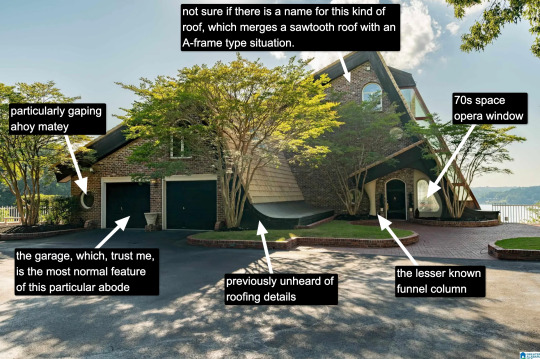
Now, I know what you're thinking: "Come on, Kate, that's a little kooky, but certainly it's not McMansion Heaven. This is very much a house in the earthly realm. Purgatory. McMansion Purgatory." Well, let me now play Beatrice to your Dante, young Pilgrim. Welcome. Welcome, welcome, welcome.

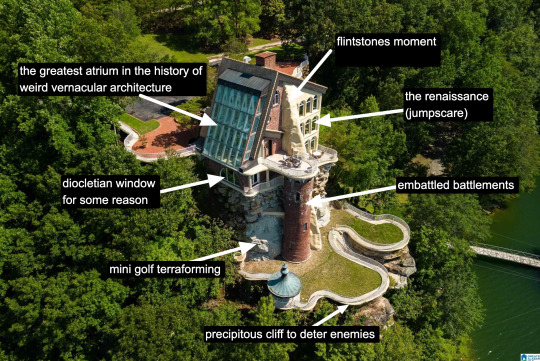
It is rare to find a house that has everything. A house that wills itself into Postmodernism yet remains unable to let go of the kookiest moments of the prior zeitgeist, the Bruce Goffs and Earthships, the commune houses built from car windshields, the seventies moments of psychedelic hippie fracture. It is everything. It has everything. It is theme park, it is High Tech. It is Renaissance (in the San Antonio Riverwalk sense of the word.) It is medieval. It is maybe the greatest pastiche to sucker itself to the side of a mountain, perilously overlooking a large body of water. Look at it. Just look.
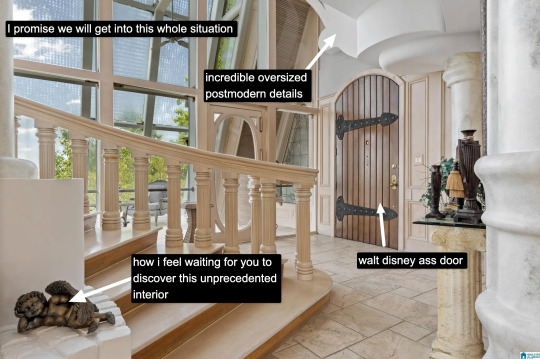
The inside is white. This makes it dreamlike, almost benevolent. It is bright because this is McMansion Heaven and Gray is for McMansion Hell. There is an overbearing sheen of 80s optimism. In this house, the credit default swap has not yet been invented, but could be.
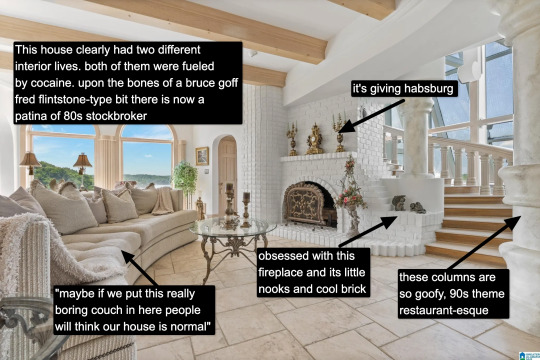
It takes a lot for me to drop the cocaine word because I think it's a cheap joke. But there's something about this example that makes it plausible, not in a derogatory way, but in a liberatory one, a sensuous one. Someone created this house to have a particular experience, a particular feeling. It possesses an element of true fantasy, the thematic. Its rooms are not meant to be one cohesive composition, but rather a series of scenes, of vastly different spatial moments, compressed, expanded, bright, close.
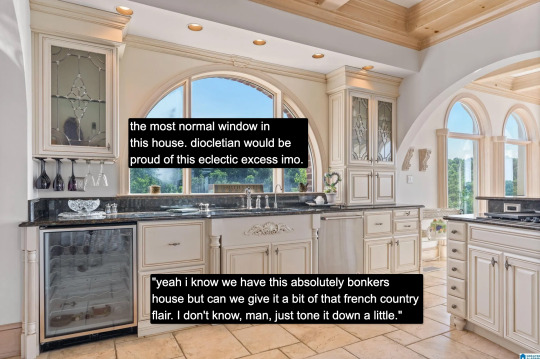
And then there's this kitchen for some reason. Or so you think. Everything the interior design tries to hide, namely how unceasingly peculiar the house is, it is not entirely able to because the choices made here remain decadent, indulgent, albeit in a more familiar way.

Rare is it to discover an interior wherein one truly must wear sunglasses. The environment created in service to transparency has to somewhat prevent the elements from penetrating too deep while retaining their desirable qualities. I don't think an architect designed this house. An architect would have had access to specifically engineered products for this purpose. Whoever built this house had certain access to architectural catalogues but not those used in the highest end or most structurally complex projects. The customization here lies in the assemblage of materials and in doing so stretches them to the height of their imaginative capacity. To borrow from Charles Jencks, ad-hoc is a perfect description. It is an architecture of availability and of adventure.
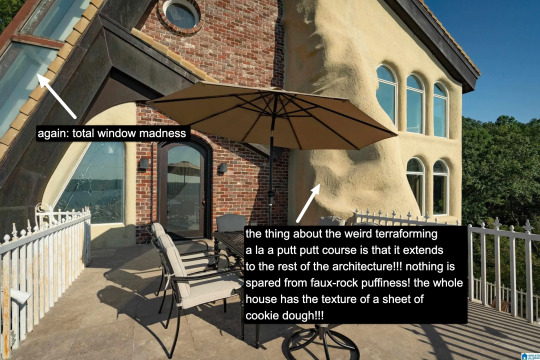
A small interlude. We are outside. There is no rear exterior view of this house because it would be impossible to get one from the scrawny lawn that lies at its depths. This space is intended to serve the same purpose, which is to look upon the house itself as much as gaze from the house to the world beyond.
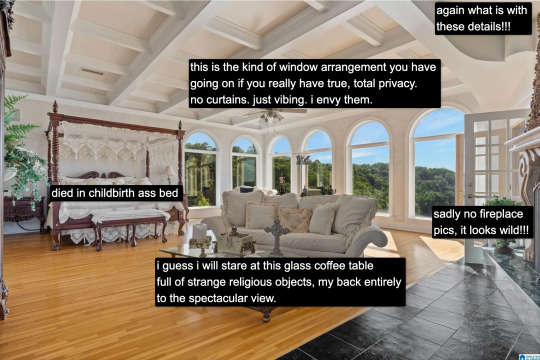
Living in a city, I often think about exhibitionism. Living in a city is inherently exhibitionist. A house is a permeable visible surface; it is entirely possible that someone will catch a glimpse of me they're not supposed to when I rush to the living room in only a t-shirt to turn out the light before bed. But this is a space that is only exhibitionist in the sense that it is an architecture of exposure, and yet this exposure would not be possible without the protection of the site, of the distance from every other pair of eyes. In this respect, a double freedom is secured. The window intimates the potential of seeing. But no one sees.
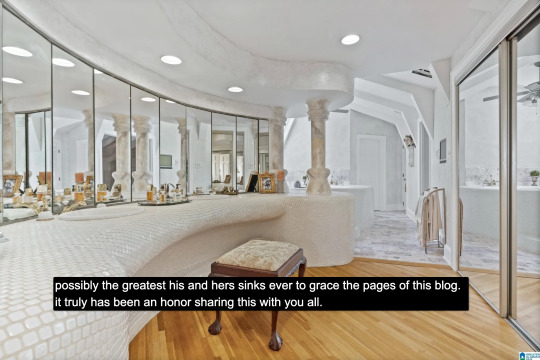
At the heart of this house lies a strange mix of concepts. Postmodern classicist columns of the Disney World set. The unpolished edge of the vernacular. There is also an organicist bent to the whole thing, something more Goff than Gaudí, and here we see some of the house's most organic forms, the monolith- or shell-like vanity mixed with the luminous artifice of mirrors and white. A backlit cave, primitive and performative at the same time, which is, in essence, the dialectic of the luxury bathroom.
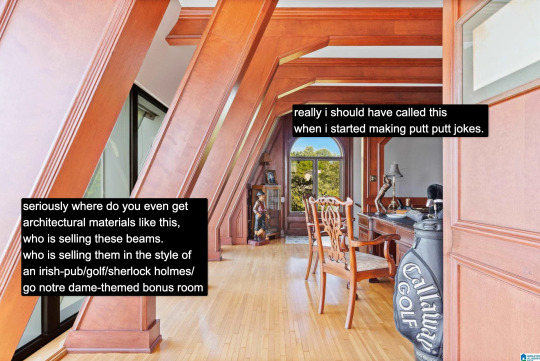
And yet our McMansion Heaven is still a McMansion. It is still an accumulation of deliberate signifiers of wealth, very much a construction with the secondary purpose of invoking envy, a palatial residence designed without much cohesion. The presence of golf, of wood, of masculine and patriarchal symbolism with an undercurrent of luxury drives that point home. The McMansion can aspire to an art form, but there are still many levels to ascend before one gets to where God's sitting.
If you like this post and want more like it, support McMansion Hell on Patreon for as little as $1/month for access to great bonus content including a discord server, extra posts, and livestreams.
Not into recurring payments? Try the tip jar! Student loans just started back up!
43K notes
·
View notes
Text
Okay okay one more reflection from 8x13 cause it’s Friday night and what else am I doing: Eddie’s absolution of his mom and damnation of his dad—and the way that parallels his absolution of Shannon and damnation of himself—brings up reallllllly interesting questions for me about Eddie’s social scripts about masculinity and femininity, and heterosexual couple dynamics.
I am simultaneously catching up with the show back in season 2 + watching current episodes, so please correct me if I’m wrong, but I feel like Eddie seems to have a bit of protective/chivalry goggles on when it comes to the women in his life, in a way that also prevents him from acknowledging when they do him wrong. Continually dating only women, then, puts Eddie in this position of being unable to blame them for anything that went wrong, which allows him to constantly pile that guilt and shame back on himself (perhaps…because he already feels guilty dating people he knows he can’t love…which maybe he blames on still being hung up on Shannon…but maybe…is…NOT that…rampant speculation here).
So what does that mean for Eddie if he acknowledges any attraction to men (and Buck in particular)? It is clear that social scripts for heterosexuality have been DEEPLY ingrained for Eddie, and he tries to follow them to a T, so what does that mean when there’s not a script to follow? And what does that mean for his own self-awareness and self-forgiveness if issues come up within a queer relationship? He has never had any issue calling out men who fuck up, from what I’ve seen, and even the Buddie of it all aside, I feel like that could be sooooo liberatory for not-straight Eddie, to not always have a script to fall back on that tells him he’s in the wrong, to be able to actually appraise a situation with a significant other and be like oh I fucked up but so did you…
Whichhhhhh now brings me to the Buddie of it all which is, just, I really can’t imagine a more complementarily written couple than Buck and Eddie because—someone who Eddie can call out when he fucks up? And apologizes? And someone he can apologize to, and be forgiven? Someone who doesn’t run when he breaks down (not that it’s Shannon’s fault; it was a tough ass break on both sides)? Someone who he can authentically recognize the strengths and weaknesses of and love anyway, without any social scripts to follow? THAT would be great storytelling, aside from how much I want it 😅
#buddie#911 buddie#buddie 911#eddie diaz#evan buckely#911 8x13#diaz family#helena diaz#ramon diaz#shannon diaz
14 notes
·
View notes
Note
Hello! Sorry if you’ve posted about this somewhere already/if it’s redundant, but I thought your coinage of “transMad” was very cool and I’m wondering what that term means to you? I’m really happy to see other people talking about madness being intertwined w their gender/transness and looking forward to checking out your reading lists :))
thank you so much for asking about one of my favorite things to infodump about!! rather than rehash a bunch of stuff, if it's okay, I'm going to borrow a few quotes from past!me that i've published in different places // offer you some things of mine to read.
broadly, though, i use transMadness as a way to explore the identificatory, epistemological, methodological, and theoretical implications of an orientation (to use Sara Ahmed's term) toward bodymind noncompliance and self/selves-determination. this orientation refuses to delineate diagnostically between Maddened / transed experiences of the world/our many worlds, and instead takes this shared/overlapping ground as a jumping off point for solidarity and speculation - that is, something that allows us to imagine otherwise worlds / make them manifest through creativity and collaboration.
(Ha, and I claimed i wouldn't talk too much...famous autistic last words)
ANYWAY. here are some clips that might help explain more dimensions of transMadness. note that, in my dissertation-in-progress, i'm focusing on xeno/neogender and/as self-diagnostic cultures among queercrip and transMad internet users. i'm interested in the anti-psych liberatory potential of this digital community work, especially as it centers forms of knowledge and scholarship devalued within Academia Proper, especially because so much of it is made by and for disabled, Mad, queer, trans people, esp. youth. Onward to quotes!
On transMad epistemologies: citation/power/knowledge:
I’ll spend most of this piece looking not at what transMad is, but what it does. First and foremost, transMad cites. Even its name alludes to other portmanteaus: neuroqueer and queercrip being the best-known among them. Many people have offered many different (ever-“working”!) definitions of these terms; today, I offer co-coiner Nick Walker’s (2021) definition of neuroqueer: a verb and an adjective “encompass[ing] the queering of neurocognitive norms as well as gender norms” (p. 196). In terms of queercrip, I also return to its coiner, Carrie Sandahl (2003), who for whom the queercrip (as person and as method/movement) confuses the diagnostic gaze, bears sociopolitical witness, and performs glitchful[4], incongruous, confusing in(ter)ventions into possible community. At base, “queer” and “crip” appear as analogous, reclaimed slurs signifying marginalized transgression. When combined, they describe a loop, perhaps a Möbius strip: crip (ani)mates queer, queer tells-on crip. The specter of crip haunts queer—and even more explicitly, as we will see, trans—and the crip(ped) bodymind holds, moves, and fucks queerly. Who knows where “queer” stops and “crip” and “neuro” begin? Likewise, transMad, whose citational style leaves little room for diagnostic clarity amidst a pastiche of noncompliant text.
On transMad epistemologies: multiplicity (h/t @materialisnt):
They encourage us to remove others’ names from our bodies, to reign in unruly citations, to set “boundaries” which violate Mad, crip ethics of care (see Fletcher, 2019). In truth, any framing of individual authorship in which the body text is “mine” and the citations gesture “elsewhere” belie the inherent interdependence of all intellectual life, and particularly of transMad intellectual life. transMad plural scholar mix. alan moss (2022) argues in relation to the pathologization of multiple systems: “all people, indeed all that exists, is a system that itself is constantly enmeshed in several overlapping and interconnected systems.” In short, I am full of Is, and will continue as many more. Just as disability justice helps us understand all life as interdependent and deserving of access, a transMad approach sees our selves as numerous and fuzzy. We have permission to dispense with the need for tidy texts, with our interlocutors, edits, and iterations either obfuscated entirely or exclusively relegated to a bibliography. transMad citation may thus be considered akin to visible mending[6], creating flamboyantly messy, multiplicitous work that does not seek to pass as objective or discrete.
On the value of (crip) failure and/as "virtuality":
Don’t get me wrong: Zoom PhD work is a failing enterprise. That is to say, it is a queercrip, transMad enterprise, which is to say, it is a beautiful, beautiful project. Mitchell, Snyder, and Ware describe such “fortunate failures” in the context of “curricular cripistemologies.”5 Coined by Merri Lisa Johnson, the term “cripistemologies,” refers to “embodied ways of knowing in relation, knowing-with, knowing-alongside, knowing-across-difference, and unknowing,” ways which frequently exist outside the purview of mainstream academia.6 Curricular cripistemologies, then, refer to an intentional, queercrip deviation from normative pedagogical approaches which trades the corrective impulse of “special ed” and other rehabilitative programs, and offers instead a generative noncompliance.7 That is, rather than trying to identify, isolate, and ameliorate difference, curricular cripistemologies lean into difference as it is experienced by disabled students ourselves, querying how atmospheres of in/accessibility shape normative approaches to education and how the embrace of “failure,” not as a last-resort but as a first choice, poses potentially transformative possibilities.
On transMadness and fat liberation: (for @trans-axolotl's Psych Survivor Zine)
A transMad, fat approach to disorderly eating requires making connections with humility and understanding, and, as I discussed above, engaging in compassionate, critical interrogation of our own anti-fatness.
[...]
A transMad, fat, abolitionist politic is one that makes room. We imagine beyond the cage, even if the details of that imagining are not yet clear. Just as we have carved micro-sites of support within violent digital and in-person contexts, just as we have learned to think about our lifeworlds beyond the paradigm of “recovery or death,” we can also reconceptualize fatness not as the enemy, but as another form of bodymind noncompliance in alliance and/or entanglement with disorderly eating practices. For thin disorderly eaters, this requires us to fundamentally challenge the way we view food and embodiment, even while maintaining a Mad respect for alternative ways of approaching reality.
On xenogenders, virtuality, and self-determination:
It is this very “irrationality” –– the “unrealness,” the “you’ve-got-to-be-kiddinghood,” that is most frequently weaponized against xenogenders, as well as their newly-coined sets of xenopronouns. The perceived and actual virtuality of xenogenders is often placed against the notion of “actuality,” in this case, of “real” (or “practical”) genders and pronouns to be used in one’s “real life.” Disabled activists have rightly resisted the distinction between online and (presumed-offline) “real life,” given that this categorically excludes homebound bodyminds, as well as those without IRL social and support circles. That said, I believe the virtual –– as almost, not-quite, proximite, making-do –– is incredibly useful in thinking about xenoidentities as transMad tools –– particularly, as transMad tools of underground collaboration / co-liberation.
[...]
What if gender was a project we wanted to fail? That is, what if trans- was a process not of getting better, not of moving-toward a bodymind more sane, more straight, and more cisheteropatriarchially desirable, but rather a line of flight on a longer trail to illegibility? Indeed, what if we replaced pathology’s narrow “path” with a trail lighted by the language of our comrades, whose linguistic interventions make and break gender in ways heretofore unimaginable? Xenoidentities, both individually and as a trans-gressive M.O., are fundamental to a broader transMad project of crafted, collective illegibility; intersubjective citation (imagine what it feels like for someone to be the gender that you coined!); and collective care that refuses a politics of cure. Crucially both virtual and digital, xenoidentities are furthermore a manifestation of the power of trans, predominantly disabled digital counterpublics, who overturn the hierarchy which places the IRL-real above the digital-unreal, making unruly, Mad space in which (with apologies to Donna Haraway) a hundred xenoselves might bloom.
On Maddening queer "diagnosis":
In her indictment of all “Kwik-Fix Drugs,” Gray further indicates the practice of forced treatment as in and of itself as a project of violent normalization, regardless of specific target or reason. The intentional ambiguity between her narrative of Madness and her narrative of asexuality disrupt mounting demands for a healthy (sanitized, neoliberal, and consumable) queerness. A Mad ace approach identifies these demands as, indeed, comparable with cis heteronormative notions of sexual maturity and responsibility – the idea that participation in culturally-normative sexual practices is a prerequisite for health (Kim, 2011, 481) and thus, personal autonomy (Meerai, Abdillahi, and Poole 2016, 21). By fusing the “lack of sexual appetite” attributed to her medications for bipolar disorder with her asexuality, Gray destabilizes the binary between healthy-sexual-diversity and unhealthy-psychopathology. She is once again disrupting contemporary queer impulses to dissociate from ongoing histories of pathologization. Here, Mad and queer/asexual activism are as inseparable in text as they are in Gray. Gray and her comrades collectively refuse both sexuality-as-“rehabilitation” (See Kim 2011, 486) and asexual acceptance predicated upon normative “health” (Kim 2010, 158) – that is, they Madden asexuality. Twoey, in her own voice, remixes the sources of her own pathologization, staggering the supposedly-divine pronouncement of the DSM across pages and bookending its extracts with her own writing and art. In this undermining of the DSM’s epistemological polish, Gray disrupts the domination of written prose over poetry and visual art, while also critiquing the role of the DSM in commercialized health “care.” Her zine opens with the lines “sex sells and sex is sold / sex was being sold and i didn’t buy” (Gray 2018, n.p.). Gray indicates a pathology perceived not only in a refusal to practice sex, but also in a refusal to buy (into) it. After all, a refusal to buy into existing sexual paradigms is for her also a refusal to buy into a feminized reproductive mandate.
95 notes
·
View notes
Text
When incorporating disability into your politics, it is good to remember that the allocation of resources is one of the central questions that divides political ideologies. It is the “why”, whereas most of the other questions are sorting out the “how”.
I think one of the core tensions that plays out between disability movements and other liberatory movements is that knowledge of disability fundamentally reshapes how you understand the allocation of resources. In one sense, to be disabled is to need resources allocated to you because you cannot get them on your own.
•Disabled people know, experientially, that we need flattened hierarchy; the hierarchies of the medical establishment kill us and further disable us. They strip away our access to the resource that is medical knowledge and medical care.
•We know that we need an ecological relationship that is sustainable and stable, because the current eugenic environmental management system is sometimes the cause, and more often the exacerbator, of our disability. But also because we know that the scarcity of resources it is progressively creating will kill us first
•We know that we need continual industrial production to maintain the means by which we can be diagnosed and treated, and that even a short term collapse of production will kill many of us.
•we also know that there must be a fundamental reorganization of all society because we know that the current organization is also killing us, and that methods of gradual change will not prioritize us, and that many of us will be dead by malice or neglect before they come into effect.
•we know that we need ongoing, active care to survive.
•we know that a society cannot meet the needs of those whose needs it does not understand. We know that any plan for meeting needs, or granting rights, or ensuring values must explicitly include us, because we know that the nature of disability is that things do not work the same for us as they do for others.
The lived experience of disabled people creates a direct challenge to the ideas of resource allocation that those with less experience have developed. We see the gaps in their proposals because we know we are the ones who will fall through them. It is easy for an abled political theorist to say “we will work it out when we get there”. But someone who will die with 2 missed doses? they must say “will we get there?”
This question is often met with dismissal, for understandable reasons. At its heart, the existence of the disabled reminds the theorists that their ideas are incomplete.
But, for a moment, I would ask you to consider us a prompt, instead of a threat. Yes, we can point to the gaps in your ideology. But we are not doing this to hurt you, or even to say you are wrong. We point to the gaps because we want to help you fill them.
So, political thinkers, take a moment to imagine your world. Imagine the look, the feel, the smell. Think of your social relations, your food, your housing. Conjure up every beautiful dream for society that you’ve built.
Now ask yourself
1. In this society, how would someone get their medication reliably, Every single day? How can they ensure the quality and safety of that medication?
2. In this society, how would someone seek information about what’s wrong in their body? Are there widely available high-tech diagnostics, like MRI machines? (Bonus question: how does your society go about inventing and creating new high tech diagnostics?)
3. How would someone who cannot move their body bellow their neck get around. How would they get food, water, shelter, socialization, and freedom to leave their domicile and participate in the world?
4. How would someone who cannot read, write, or speak due to intellectual disability be able to live, and to have meaningful access to all the things that you believe humans deserve in your society?
5. In trying to build this society, transitioning from our current world to this new one, how would the people mentioned in above questions survive the transition?
And try to answer these questions. It’s okay if you don’t know right away. It’s okay if you have to think about it, do some research, or talk to some people. You love dreaming about the world we could build, right? This is more information for you to develop and refine that dream.
These questions are not exhaustive, at all. But they are a good starting point to check for gaps in your plan for reality, and to see who is currently falling through.
#text post#disability#long post#politics#prefigurative politics#anarchism#cpunk#socialism#communism#leftism#rose baker#disabled#liberation#utopia#cripple punk
200 notes
·
View notes
Text
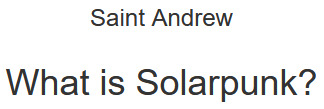
The Politics & Art of Solarpunk
Although solarpunk never had a particular political ideology assigned to it, it’s been embraced by liberatory ideologies of all flavours. From social ecologists to post-civ anarchists to green socialists.
The philosophy of solarpunk and the politics of anarchism are practically built for each other. Anarchism emphasises personal freedom and collective liberation from hierarchies, authoritarianism, and exploitation. It seeks, as an ongoing project, common ownership, voluntary cooperation, horizontal organization, and mutual aid. Anarchism has generally been ahead of its time on many political issues, from queer to women’s liberation, and its approach to ecology has been no different.
Solarpunk can easily be synthesized with anarchism, and many of its various strains, as it explores the possibilities of liberatory technology, the localization of production, an end to destructive and wasteful consumption, and a reorientation of our relationship with society, work, nature, and ourselves.
It all sounds pretty gooey and feel good. But I want to briefly address those that have lost hope in a better world. Who are stuck thinking that this, largely, is the best that we can do. There’s this idea in politics these days that imagination has no place in our “pragmatic”, no-nonsense world. Which is just false. Humans are flexible creatures, capable of a whole range of social arrangement. If everyone limited themselves to the confines of what is, we wouldn’t be where we are today. It’s time to take some steps forward, with a variety of tactics in hand.
One of which is art. Art has a tremendous influence on us. Music, books, paintings, TV shows, movies, etc, they shape our ideas of what humanity is and what humanity can be. While there haven’t been many major examples of solarpunk art and entertainment yet, I think we can change that. There are interesting stories to be explored and debates to be had, through art. Imagine a novel that explores the different sides and dimensions of the debate on meat consumption in a solarpunk world or a comic that follows a community’s journey as it seeks to rewild and resuscitate the surrounding ecology.
Or picture this. Maybe alongside a game that imagines a horrifying endgame that maintains capitalism, like Cyberpunk 2077, we imagine an uplifting, yet still challenging game that exercises our ability to balance the needs of our local ecosystem and deal with the difficult decisions and conflicts that arise as we reorient our place in the world. Could call it Solarpunk 2033 or something. There’s a free idea right there.
#solarpunk#eco-anarchy#post-civ#autonomous zones#autonomy#anarchism#revolution#climate crisis#ecology#climate change#resistance#community building#practical anarchy#practical anarchism#anarchist society#practical#daily posts#communism#anti capitalist#anti capitalism#late stage capitalism#organization#grassroots#grass roots#anarchists#libraries#leftism#social issues#economy#economics
39 notes
·
View notes
Text
Solarpunk as Aspirational Future
Our stories of the future have, for too long, been apocalyptic, techno-fascist, or dystopian. The genres of cyberpunk and speculative fiction are dominated by extrapolations of current systems instead of better systems that could be. Although these stories may be intended as warnings, at a certain point, they become self-fulfilling. The sheer volume of these pessimistic visions has weighed down our collective imagination; many people are resigned, having accepted them as fate. Mark Fisher calls this phenomenon “capitalist realism,” a phrase intended to encapsulate the quote 'It's easier to imagine the end of the world than the end of capitalism.' As Margaret Thatcher would have us believe, “there is no alternative.”
Early solarpunk writer Connor Owens stressed the importance of solarpunk as “an eco-futurist movement which tries to think our way out of catastrophe by imagining a future most people would actually like to live in, instead of ones we should be trying to avoid.” He went on to explain, “Solarpunk is a rebellion against the structural pessimism in most visions of how the future will turn out. Not to say it replaces pessimism with Pollyanna-ish optimism, but with a cautious hopefulness and a daring to tease out the positive potentials in bad situations. Hope that perhaps the grounds of an apocalypse might also contain the seeds of something better; something more ecological, liberatory, egalitarian, and vibrant than what came before, if we work hard at cultivating those seeds.”
To combat Thatcher and the purveyors of capitalist realism, Solarpunk is about alternatives. Warren Ellis used the term “refuturing”—in the sense of “rewilding”—to describe Solarpunk. Solarpunk seeks to rewild our imaginations, captivate us with success stories from the near future, ease our psychic burden, and motivate us toward constructive action. It also crucially implies that the landscape of our collective imagination is not a monoculture; it should be an abundant ecosystem.
21 notes
·
View notes
Text
I think the whole pop culture front of imperialism is honestly pretty interesting and revealing for how starkly they show certain dynamics. One of the things that comes up frequently when invoking the ussr for example is this image of a bleak grey cultural landscape where fun was outlawed, there were no movies, no fiction, no music, and anything from the outside was strictly banned. A cursory look, though, reveals a different picture. Russia was one of the biggest worldwide media importers of the 20th century, and Russians on average watched more movies and read more books than Americans at the time. To my knowledge the most popular were Indian and Mexican titles. But Americans don't really know or care about Russian, Indian, or Mexican media, so all of this is invisible compared to the imagination of rock and roll and Hollywood liberating the poor benighted people of the East.
You see this even moreso today with the outrage expressed towards the reception of American movies in China which has, in the last 6-7 years, morphed into outrage that domestically produced Chinese movies are more popular in China than American movies. The tacit assumption seeming to be that clearly ours are superior and are, again, somehow a liberatory force against authority. But how often do you hear an American talk about a Chinese movie?
None of it is really about movies, just protecting and projecting a sense of American cultural superiority.
44 notes
·
View notes
Text
Hi! I hope everyone is doing well. I am popping up to let you know that I’m alive, that there’s a lot going on, that I still love YR, and that I’m thinking about boundaries and priorities.
I loved Young Royals season three. I especially love how it engaged with the legacy of Erik and the systems of Hillerska. I love that it took the idea of the legal system providing catharsis and that it threw that out the window. I love the way characters got words for what they were going through, how Felice got to name the racism happening to her and August got words to name his disordered eating. Most of all I loved the way Lisa wrote Sara’s relationship with her father and her reconciliation with Simon. That meant so much to me, and I can’t wait to imagine a future for the Eriksson siblings.
Here is a brief list of things I loved about the finale. They were all written in the afterglow of seeing the episode. I stand by them. Especially how much I loved Wille’s ending, and what happened there.
In the coming weeks, I’m sure there’ll be stuff I’m more critical of or don’t feel as strongly about. I especially have mixed feelings about the way Lisa seemed to structure 3.5 in a way that mimics the emotional roller coaster of trauma. I’m not really focusing on that stuff here or now, because I don’t want to. But it’s on my mind, and I don’t know if I’ll end up posting about it here and elsewhere.
At present this post isn’t rebloggable or tagged with much of anything. That’s because I’m trying to figure out the best way moving forward with tumblr. I don’t know if I want to delete this blog and abandon it entirely, but the pressure to present a curated version of myself is too much, and is a pretty big trigger for things like rejection sensitivity and anxiety. The pace here is also too fast and there is no way to keep up with everything, and (forgive me for this cardinal sin in tumblr-land) I wish I had some easier way to not see the same sets of gifs a hundred times with the same commentary. I’m experimenting with slower ways of doing fandom, where I can enjoy myself more.
I do, however, want a way to get the cultural footnotes for Young Royals, especially when they help me write better fic and create better fanworks. I know there’s some pretty darn useful posts about how lines get translated and various holidays and traditions (and looking forward I would like to know more about universities in Sweden, and how the monarchy works and such.) So I want to be able to find the stuff I need without having to spend as much time on what I don’t need. The resource posts people make are truly helpful.
And I also have some other fannish things I want to see here, like Les Mis and Interview with the Vampire. And the memes are nice. I miss the memes.
Before I make the decision about how I engage, I think it will be useful for me to know my priorities. So I’ve thought about them a bit, and I want to make the decisions that align with my priorities. Here’s what I want to focus on moving forward:
I want to spend more time creating. The thing that has always brought me the most genuine joy in this fandom is writing fic. YRS3 ended in a place of possibility for so many characters, and I want to keep writing about them and learning about them that way. (I won’t even lie, of course most of my ideas are about August—August and Kristina working on their intergenerational cousin relationship, August getting pulled into weekly DND sessions with Wille and Simon so they can all get better at being human together while pretending to be elves or something, August doing the personal and liberatory work that allows him and Sara to one day have a Second Chance Romance with they’re older, even August/Nils because oh boy did that season give me ideas about them I never knew I had.) One of my goals is to cut down on browsing time significantly so that I spend more time writing, especially so I can finish Heart and Homeland. I think it’ll make me happier.
I want to spend more time helping others create. Some of the most meaningful experiences I had in this fandom involved being a beta reader or hearing out another person’s fic ideas, and getting to live in that space of creation and collaboration. For that reason, I’d like to still make new YR connections on occasion, especially with people who wanna share their writing process with me. Tumblr may or may not be a place to do that. I’m still figuring out where stuff should happen.
I want analysis to be something I do as part of my creative process, and that’s it. I don’t know if this is fully true, but it felt like ten years ago there was more fandom meta focused on what fans wanted to write in their fanfics, and how their interpretations of canon led to them creating cool art. There was some meta that was about how to interpret canon “correctly” but that wasn’t the priority. Now, it feels like—and this is true even outside of YR fandom, so this is no reflection on YR specifically—there is more emphasis on having the “correct” interpretation of canon. About getting it right, and having the right predictions and interpretations. It feels competitive in a way that wears me down. From this point forward, when posting analysis, I’m going to ask myself, is this furthering my creative pursuits and my understanding of the writing process more generally, or am I just trying to win an argument? If the answer is just to win, then I’m not going to post my argument. That runs counter to my goals.
I don’t want to engage in any space where anonymous discourse flourishes. Even when well-intentioned. Being away for a while was clarifying for me on that point. Turns out one of the biggest triggers for my anxiety and shame are extensive, heated conversations where I don’t know who is saying what and who I can trust. Spaces where there’s a lot of anon conversation are probably going to be ones I block and unfollow first moving forward. It just seems like a good baseline for how I engage.
So this is where I am as of now. I’ll probably continue to hold off on doing much posting in the coming days, but I did want to poke my head up for air for a second to let people know what the state of everything is.
Here’s one picture of the plushes for the road:

And here’s a picture of the waffles I ate on finale day:

Oh, to have cloudberry jam and time spent with friends. These things are truly joyous.
32 notes
·
View notes
Text
Below is a transcript of the keynote speech I delivered for the 14th Conference on East-West Cross-Cultural Relations at the American University in Cairo.
How the fuck am I supposed to teach Mark Twain?
I repeated this question as I sat on the bus traveling to campus. It was my first time meeting classes since October 7. I would be walking onto the same campus, but the world in which it is situated had forever changed. Trying to separate campus from Palestine was no more viable than trying to separate Christ from the crucifix.
Mark Twain has something to do with Palestine—he wrote about it, after all, in a way that would please Zionists a few generations later. With a bit of imagination, everything has something to do with Palestine. This is so because Palestine, while formally absent as a nation-state, exists as both a historical and sociological presence in the minds of people across the world. Indeed, we affirm the reality of Palestine with every refusal to grant legitimacy to its occupier.
Still, Twain wouldn’t cut it. Nor would the more politically-oriented readings assigned to my other two classes. I wanted to discuss Palestine as Palestine, without analogy, without mediation. The beginnings of a genocide were already evident. There’s a simple, inviolable rule about genocide: normal life must come to a halt until it is defeated.
What can a literary critic and college instructor do to help defeat genocide? The obvious answer is “nothing,” but I’m not willing to concede the point so easily. What we can do depends on how we conceptualize the scope and purpose of literary criticism. Scholars like to call emphasis on revolutionary outcomes prescriptive, and I suppose they’re right, but certain events in the world demand a kind of vigor socialized out of us by graduate school and the job market. I’m saying that sometimes it’s okay to be prescriptive. Who does it help when we spend all our time slogging around in nuance and ambiguity? What purpose does it serve other than social climbing and self-gratification? In Palestine right now, not too far from where we’ve gathered, millions of people are being bombarded, starved, displaced, imprisoned. I condemn it without qualification or concern for the bourgeois etiquette of higher education.
And I can condemn it in literary criticism without sacrificing the creative touch that often makes the genre so rewarding. Ghassan Kanafani has already shown how it can be done. So have Toni Morrison, Robert Warrior, Raymond Williams, Viet Nguyen, Audra Simpson, James Baldwin, and Christina Sharpe. In his book On Zionist Literature, recently translated into English, Kanafani offers a rigorous analysis of Israeli culture and society, adeptly interrogating Zionism’s discursive norms, philosophical assumptions, and ethical inconsistencies. He fulfills all the conventional tenets of literary criticism and still manages to affirm national liberation. There’s no contradiction. The liberatory aspects of criticism have been suppressed by publishers, by tenure committees, by culture magazines, by scholars affiliated with the CIA—in short, by various organs of the ruling class. National liberation isn’t considered an unacceptable methodology because of some natural, ahistorical standard of proper literary study. The standard is political. It was always political. And it’s most political precisely when nonpolitics is the demand.
10 notes
·
View notes
Note
hey i'd really love it if you could say more about biopolitics? i hadn't heard that before and it seems fantastic.
😅 u guys humor me too much- these type of asks are like catnip for me i am rolling around on the floor
biopolitics was originally conceptualized by foucault in a series of lectures- the very simple explanation of it (which foucault scholars probably would feel doesn't do it justice) is that the state has a vested interest in creating citizens who are "healthy" (as defined by the state usually by military/work readiness) + reproducing more "healthy" citizens (in this way it often intersects with outright eugenics). people often refer to it as the politics of "making live + letting die" (necropolitics by achille mbembé is an incredible analysis of this second part, focused on colonial power's interest in determining who dies)
what this means is that, at its core, the state engages in programs to improve the "health" of the population not out of altruism but because it needs a supply of work-ready, combat-ready, reproduction-ready individuals. the concept of "health" is tied up in one's ability to perform labor in service of the state, so much so that disorder or the severity of disorder becomes defined by this ability. public health efforts center not on decreasing suffering but on restoring the population to a condition in which they can once again perform labor (including reproductive labor) + serve the greater needs of the state.
my friend cora at umadison did an excellent presentation on how the u.s evokes within "anti-obesity" campaigns a concern that "obesity" is a threat to military readiness. messaging concerning family planning/abortion are often engaged by the state to coerce certain ppl into having children + others NOT to, based on the idea of the Type of Citizen they want. on a deeper level, this haunts us from birth- were there programs to try to improve your mother's pregnancy? public school health surveys? scoliosis tests? presidential fitness tests? irt COVID-19, whose death was seen as acceptable + whose death was seen as worth preventing? was prioritizing a 'return to work ' an out-of-the-blue approach or a natural conclusion of a public health system structured around producing + maintaining a steady supply of labor? none of this is asserting that state public health intervention is inherently BAD, just that its core motivations are not altruistic but rather political (so it has no interest in expanding into a public health model where fitness to work/serve/birth is NOT seen as the marker of health).
a very cynical read of the opioid epidemic would be that the state is so heavily involved now because it is finally impacting individuals that they want to Make Live. harm reduction is reluctantly being adopted (thanks to the tireless work of incredible activists!) but only if it can fit into the framework of Making Them Live Until They Can Become Sober. sobriety is the unspoken end goal not because it reduces suffering but because it allows for workers. the truly liberatory logic of harm reduction, which focuses on autonomy + safety + reducing suffering, is antithetical to the motivations of a state which openly despises those who don't 'produce' proportionately to what they receive.
my interest is in reimagining medicine + the body + disability + suffering outside of this biopolitical framework by acknowledging that our very definitions of all of these things have been engraved in the public imagination with labor production in mind. i'm not interested in trying to create new state programs that are 'untouched' by biopolitics because that's impossible + i can still extract tangible benefits from it (for example, i got all my covid vaccines early + for free bcuz my labor was important enough for the state to invest in my life). the idea is to engage with these programs clear-eyed + willing to look at who we Make Live + who we Let Die. most importantly, we can find what lies outside it all + envision new ways of living
130 notes
·
View notes
Text
I'm really in awe about what the Barbie movie was able to do with men/masculinity given the premise.
The "Before" of the movie is a world where both:
in the real world, patriarchy is fully functional, even as everyone claims misogyny is dead
in the imaginary world, men are ignored/emasculated/subjugated
The worries of MRAs/incels/MGTOWs are given enormous care by this plot, even though it's something that only exists in the imaginary world. The Kens are living in the beta/cuck dystopia constantly talked about by awful men on the internet. Like these MRAs, Ken can see himself as a victim of girl power even as that victimhood isn't playing out in the real world.
But what's the point of imagination, after all? Playing out alternatives, thinking through what's possible. The Barbies realize that they need to apologize for sidelining the Kens, even though that sidelining only took place in the imaginary world because it was an imaginary escape from a misogynistic real world. And the Kens don't know how to demand more agency without falling back on all the toxic tropes of patriarchy. At the end, when Barbie tells Ken that he needs to figure out who he is without her, she's telling him that men need to figure out how to live with freedom and authenticity without that identity coming from a power relationship over women. Ken is "Kenough" because he doesn't need to have power over Barbie in order to be free and fully human.
I've always argued that imagination is our best recourse in the the fight for a better world. This movie takes that idea and runs with it. When we can't imagine new liberatory futures, we will end up using the flawed scripts of the past (patriarchy, power hierarchy). But if we can imagine, and then criticize our imaginings, adjust, and imagine again...
#barbie#and ken#gender#patriarchy#imagination#so many big thoughts about this because of this movie#greta gerwig#toxic masculinity
71 notes
·
View notes